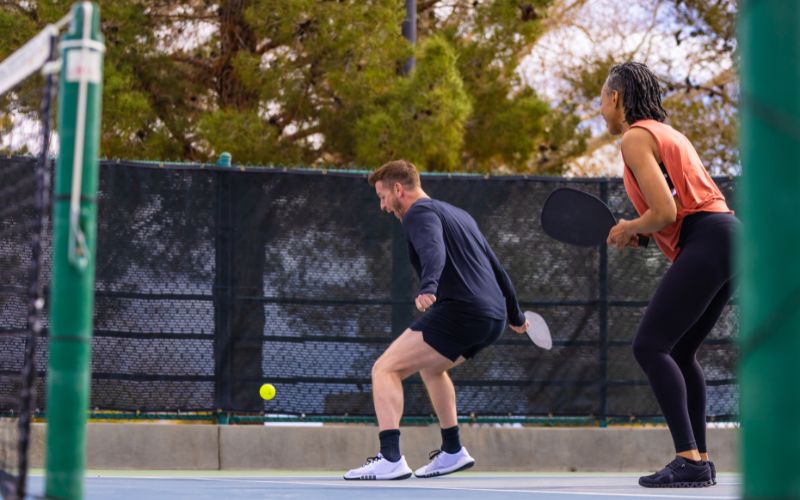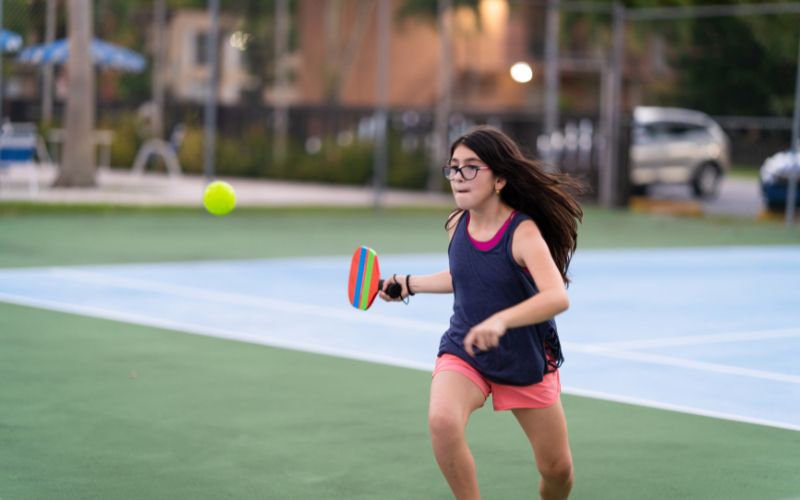Pickleball, a sport that combines elements of tennis, badminton, and table tennis, has surged in popularity in recent years. Pickleball games that can be enjoyed by all ages and skill levels, but as with any sport, the competitive edge comes with mastering advanced strategies. This article delves into the sophisticated pickleball strategy and tactics that can elevate your pickleball game from casual to competitive.
The Strategic Foundation of Pickleball
Before diving into advanced strategies, it’s crucial to have a solid grasp of the basics. Pickleball strategies are built upon a foundation of consistent serving, accurate shot placement, and effective court positioning.
Serve and Return
The serve in pickleball sets the tone for the point. An effective serve can put the opponent on the defensive from the outset. Similarly, a strong return of serve can neutralize the server’s advantage and set up offensive opportunities.
Shot Selection
Understanding when to use power versus when to employ finesse is a key strategic decision in pickleball. The ability to switch between hard drives and soft dinks can keep opponents off-balance and create openings.
Court Positioning
Good court positioning involves being in the right place at the right time. It’s about maximizing your ability to reach the ball and minimizing the open spaces your opponent can target.
Foundational Strategies:
As a pickleball expert, I can tell you that the strategic foundation of pickleball is built on a combination of shot selection, court positioning, and an understanding of the game’s unique rules. Let’s delve into some of these foundational strategies:
The Importance of Drop Shots
Drop shots are a quintessential part of advanced pickleball play. A well-executed drop shot transitions from a power game to a soft game, forcing your opponent to move forward and hit upwards, which can be a disadvantageous position in pickleball.
The drop shot is typically played when the ball is hit softly into the opponent’s non-volley zone (also known as the kitchen), making it drop quickly and forcing the opponent to hit a difficult upward shot.
Mastering the Non-Volley Zone Line
The non-volley zone line, or the kitchen line, is a critical area of the court in pickleball. Players are not allowed to volley (hit the ball out of the air) while standing within this seven-foot zone from the net. Mastering shots around this line is crucial. You want to be as close to this line as possible when hitting volleys to reduce the angles your opponent can use and to cover the court effectively.
Targeting the Opponent’s Feet
In pickleball, one of the most effective strategies is to target your opponent’s feet with your shots. This is because a ball that lands at an opponent’s feet is difficult to return, especially if they are near the non-volley zone line.
It forces them to hit upward and gives you a better chance of winning the rally. This strategy is often used in conjunction with the drop shot, where the ball is hit just over the net with a trajectory that makes it land at the opponent’s feet.
Hit Drop Shots
The hit drop shot is a softer, more precise shot designed to arc over the net and land in the kitchen. This shot is used when you’re further back in the court and need to buy time to move forward. The goal is to make the ball bounce in the non-volley zone, ideally close to the net, which limits the opponent’s ability to hit an aggressive return.
Utilizing the Non-Volley Line
The non-volley zone is a strategic area where you can force your opponent to play a groundstroke rather than a volley. By hitting drop shots that land in this zone, you can draw your opponent forward, which can disrupt their positioning and open up the court for your next shot.
Hitting Shots with Purpose
Every shot in pickleball should have a purpose, whether it’s to set up an offensive position, defend against your opponent’s attack, or force an error. When hitting shots, you should consider the placement, speed, and spin, all of which can affect your opponent’s ability to return the ball effectively.
Advanced Offensive Strategies
To take your game to the next level, you’ll need to incorporate advanced offensive strategies that can pressure your opponents and create scoring opportunities.
Stacking
Stacking is a strategy where both players on a doubles team position themselves on the same side of the court before the serve. This allows the team to maintain their strong forehands in the middle of the court, which can be a dominant position.
Third Shot Drop
The third shot drop is a soft shot hit from the baseline into the opponent’s kitchen, or non-volley zone. This shot is crucial as it allows the serving team to transition from the baseline to the net.
Erne
The Erne is an advanced technique where a player jumps from outside the court to hit a volley, thus avoiding the non-volley zone. This can be a surprise attack that catches opponents off guard.
Advanced Defensive Strategies
In pickleball, while offensive strategies are often highlighted for their flair and ability to win points, advanced defensive strategies are equally important. They can turn the tide of a game by disrupting the opponent’s momentum and creating opportunities to transition to offense. Here are some advanced defensive strategies in pickleball:
Lobbing
Lobbing is a defensive tactic used to move your opponents away from the net and push them back towards the baseline. This is particularly useful when you’re under pressure at the net or when you find yourself in a defensive position.
A well-placed lob over your opponents’ heads can give you and your partner time to reposition yourselves and prepare for the next shot. However, lobbing comes with risks, as a poorly executed lob can be easily smashed by an opponent. Therefore, it’s crucial to use lobs judiciously and with precision.
Executing a Successful Lob
- Aim for height and depth to ensure your opponents cannot hit an overhead smash.
- Mix up your lobs with your dinks to keep your opponents guessing.
- Use a lob when your opponents are creeping too close to the net, making them vulnerable to a shot over their heads.
Blocking
Blocking is a skill used to counter powerful shots from the opposing team whether you are playing doubles pickleball or playing singles pickleball, such as smashes or fast volleys. The key to effective blocking is to have soft hands, which means gripping the paddle lightly and allowing the ball to bounce off the paddle with minimal force. This absorbs the power from the hit shots and drops the ball softly, ideally into the kitchen or of your opponent, neutralizing their attack and resetting the point.
Pickleball Technique for Effective Blocking
Stay light on your feet and be prepared to move in any direction.
Keep your paddle up and in front of you to react quickly to fast shots.
Practice softening your grip and using the paddle as a shield rather than a weapon.
Baiting
Baiting is a more psychological aspect of defense, where you intentionally offer your opponent what appears to be an easy shot, tempting them into a specific response that you’re prepared to counter. For example, you might hit a slightly higher soft shot (but not too high to be an easy smash) to invite a slam, which you’re ready position to block or counter with a volley. Baiting requires anticipation and a deep understanding of your opponent’s habits and tendencies.
Mastering the Art of Baiting
- Observe your opponent’s patterns to predict their responses.
- Offer a “tempting” shot that encourages them to hit where you want them to.
- Be ready to execute a strong defensive move, like a block or a counter, as soon as your opponent takes the bait.
Incorporating these advanced defensive strategies into your game requires practice and match experience. By mastering lobbing, blocking, and baiting, you can develop a robust defensive game that frustrates opponents and creates opportunities for you to seize control of the point
Enhancing Your Strategy with Drills
To master these advanced strategies, drills are essential. They help reinforce muscle memory and improve reaction time.
Dinking Drills
Practice dinking with a partner, focusing on placement and consistency.
Third Shot Drop Drills
Work on your third shot drops by aiming for a specific target in the kitchen repeatedly.
Lobbing Drills
Practice your lobs from different positions on the court to ensure they are deep and high enough to be effective.
Learning from the Pros
One of the best ways to improve your strategy is to watch and learn from professional pickleball players. Here’s a video that showcases “7 ADVANCED Strategies to Become a 5.0 Pickleball Player”:
The Mental Game
Pickleball isn’t just a physical game; it’s also a mental one. Developing a strong mental game is crucial for competitive play.
Focus and Concentration
Maintaining focus and concentration throughout a match can be the difference between winning and losing.
Adaptability
Being able to quickly adapt your pickleball doubles strategy based on the flow of the game is a sign of a seasoned player.
Pressure Handling
Learning to handle pressure, especially in critical points of a match, is essential for success in competitive pickleball.
Conclusion
Mastering advanced pickleball strategies requires practice, patience, and a willingness to learn. By focusing on both offensive and defensive tactics, as well as the mental aspects of the game, you can elevate your play and become a formidable competitor on the court.
Stay tuned for Part 2, where we will delve deeper into specific strategies, drills, and frequently asked questions to further enhance your competitive pickleball play.







